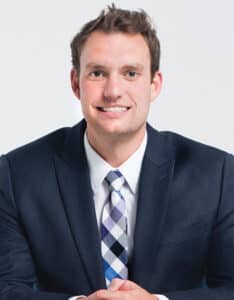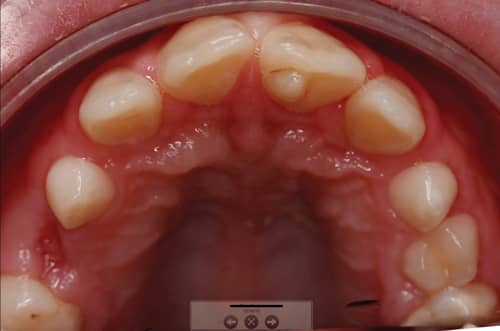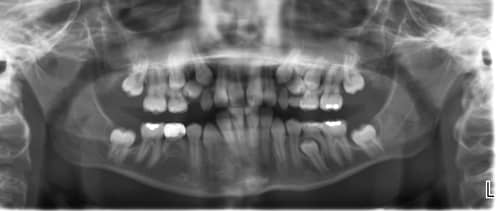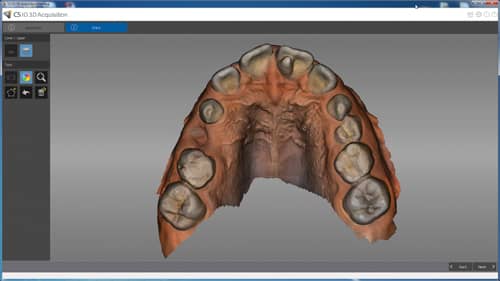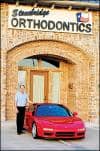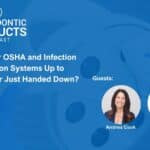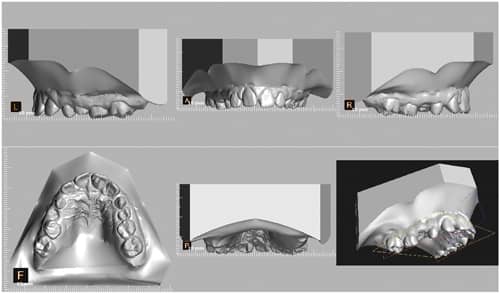
Using digital technology, like an intraoral scanner, makes things easier for patients with special needs, their parents, staff, and the doctor.
Orthodontists face a unique challenge in dealing with young patients. The age of our patients affects how we plan treatments, the technology we use, and even how our office space is designed. This is nothing new to an orthodontist; in fact, many may have entered the profession with the goal of changing the lives of children for the better. As such, we’re prepared for possible tears and tantrums from the children we treat, but can be assured of eventually revealing a beautiful smile to a more mature teenager or young adult. But what about the times when a young patient’s mental state keeps them from ever moving beyond the tears, from ever being able to fully understand the payoff at the end?
Working with patients with developmental disabilities, autism in particular, is a topic that has become more prevalent as advancements in research have given everyone—parents, caregivers, teachers, doctors—insight into how to better understand and work with children with special needs. For example, it’s been found that maintaining a strict routine offers comfort and predictability that can provide a child with autism with a way to manage anxiety. However, nothing throws off a routine like a trip to a doctor, or in the instance of the following case, several trips to two different doctors. However, with patience, consideration of the patient’s needs, and the right technology, my practice and I were not only able to provide a superbly fitting appliance, but change the course of the treatment plan for one young patient with special needs.
Clinical Case
In December 2015, a pediatric dentist referred an 11-year-old female on the autism spectrum with developmental delays, and who also suffered from epilepsy, to my practice. The referring dentist specialized in treating patients with special needs and had planned to remove the primary maxillary canines and primary maxillary second molars in the operating room in an attempt to prevent impaction of several erupting permanent teeth, followed by the placement of a maintenance appliance. The referring doctor requested that my practice take the impression for the appliance; work with a lab to have a Nance fabricated; and then deliver the appliance to the referring doctor to be placed during surgery while the patient was under anesthesia.
In order to fabricate the space maintainer, impressions would need to be taken. The parents were informed of multiple appliances (removable or fixed-Nance) that could be fabricated in an orthodontic practice and the means by which those appliances were made, ie, taking an impression. Based on feedback from the patient’s mother, it was determined that traditional impressions with trays and alginate would not be an option for several reasons. First, due to sensory issues and a history of epilepsy, the patient would be unable to tolerate material in her mouth—doing so would have possibly triggered an epileptic fit. Second, using traditional trays would have required fitting and removing bands, which most likely would have hindered us from even reaching the impression step for appliance fabrication. Finally, accuracy could not be guaranteed with traditional impression material, which would have affected the final fit of the appliance and led to possible retakes.
Ultimately, the use of Carestream Dental’s CS 3600 intraoral scanner was deemed the best course of action for obtaining digital impressions. The impressions would not only be much more accurate, thus avoiding a possible retake, but would also eliminate the need for uncomfortable trays, trying in bands, and gag-inducing PVS material.
First, an initial photo of the arch and a panoramic radiograph were taken (Figures 1 and 2). The patient was prepared for the digital impression. Whereas a typical scan with the CS 3600 takes 3 to 4 minutes in my practice, this case took 4 to 5 minutes—still incredibly fast in this special situation. The speed at which the impressions were able to be taken certainly played a role in putting the patient at ease (Figures 3 and 4).
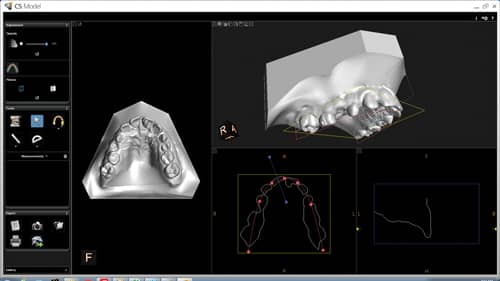
Figure 4: Typical scan time with the CS 3600 takes 3 to 4 minutes. With this patient, scan time took 4 to 5 minutes—still fast given the patient’s special situation.
Once the digital impressions were acquired, the files were uploaded to my lab of choice. A model was printed at the lab; bands were digitally fitted; and the space maintainer was fabricated and then delivered to my practice.
In May of this year, upon the referring pediatric dentist’s recommendation, I placed the appliance at my practice, deviating from the original treatment plan. The patient had grown comfortable enough with my staff and me that she allowed us to place the appliance without the use of anesthesia or operating room time. Not to mention the fit of the appliance was exceptional.
Ultimately, using an intraoral scanner instead of traditional impression trays and material minimized stress for the patient, and her parents were incredibly grateful for the smooth procedure.
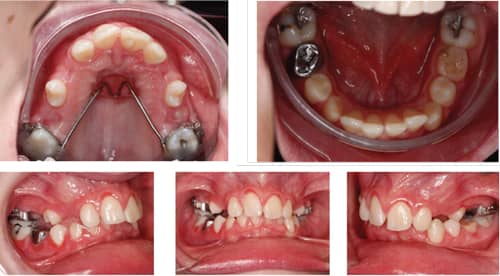
Figure 5: Intraoral photographs taken 2 months after placing the Nance appliance show it is successfully preventing the mesial drift of the maxillary first molars due to having the primary teeth extracted.
The patient was recalled in July to monitor the eruption of the impacting teeth, as well as to ensure she was able to keep the Nance clean. Intraoral photographs and a panoramic radiograph (Figures 5 and 6) revealed that the appliance was successfully preventing the mesial drift of the maxillary first molars due to having primary teeth extracted. I will continue to monitor the eruption of the teeth.
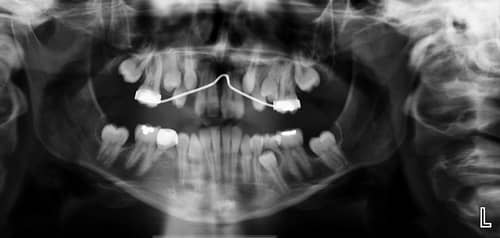
Figure 6: Panoramic radiograph taken 2 months after placement of the Nance appliance further shows success of the appliance at preventing the mesial drift. Patient will continue to be monitored.
Key Takeaways
There are several things that can be learned from this case, both in dealing with patients with special needs and in ensuring you have the right technology to do the job.
1. Communicate with Parents: All orthodontists understand what it’s like to work through a patient’s parents, but with a child with special needs, the parents become true partners in the case. In this case, we spent time in lengthy discussion with the parents, explaining the different kinds of orthodontic appliances and, more importantly, how the impressions to make them were acquired. No one knows a patient better than their parents, and the patient’s mother provided valuable insight into what the patient would and would not be able to handle physically and emotionally and we adjusted our treatment plan accordingly.
2. Minimize Stress: Of course, the comfort and mental state of the patient in this case was our first priority; however, we also wanted to take into consideration the patient’s parents and other patients. It would be difficult for any parent to stand by and watch their child in distress. At the same time, we knew that other young patients being treated nearby would become anxious if they were to see or hear the patient become upset. As even some adults can’t handle traditional impression trays, it was clear that going the traditional route would have caused far too much stress to the patient—trying in trays alone would have been frustrating and time-consuming for both the patient and staff. Thankfully, the interchangeable small tip of the CS 3600 saved the patient the discomfort of traditional impression trays. Also, the speed at which the scanner allowed us to acquire the impressions—within minutes—meant the patient spent the minimum amount of time in the chair.
3. Reduce the Chance of Retakes: As previously mentioned, children with autism find comfort in routine—therefore our goal was to treat the patient with as few interruptions to her day and with as few visits to my practice as possible. The last thing we wanted was to have to call her and her parents back to the office for a retake. We were also working on the referring doctor’s timeline leading up to surgery, so extending turnaround for the appliance from the lab wasn’t an option. Unfortunately, accuracy is not always guaranteed with traditional impressions, as technique and skill vary from staff member to staff member. Plus, there’s always the risk of expansion, shrinkage, or breaking when shipping models to a lab. As we determined that digital impressions were the best route, the result was highly accurate impressions that were uploaded to the lab via secure web portal. Using an intraoral scanner eliminated the chance of a retake or damage to model during shipping and ensured accuracy.
4. Build Trust: I have found the intraoral scanner to be a unique trust-building tool with all my patients. There’s no pain or discomfort, and young patients find it “cool” to watch their teeth begin to take shape in 3D on the computer screen. A trip to the orthodontist has suddenly become a high-tech, almost futuristic, experience. In this specific case, taking digital impressions instead of traditional impressions not only kept the patient comfortable, but put her at ease enough that she understood that we were truly trying to help her. When we told the patient, “This is so cool!” or “Just a few more seconds,” while acquiring scans, it wasn’t just to placate her or to cajole her to hold still, we meant every word. In fact, it was a surprise and a delight to hear from the referring doctor that the patient had grown to trust my staff and me enough to have us place the appliance. Using the intraoral scanner completely changed the course of the referring doctor’s treatment and cut down operating room time.
Orthodontists have used intraoral scanners for a few years now for record-keeping purposes and to create digital impressions. They eliminate impression materials, reduce costs, produce more accurate impressions, and cut down on turnaround from impression to appliance. However, while the “cool” factor of the technology and the comfort it provides young patients may be shrugged off as “nice-to-haves,” I can’t stress enough how important these little hidden benefits were in this case involving a patient with special needs. Another “little” benefit that may be taken for granted is the fact that my CS 3600 isn’t tethered to an awkward trolley but is instead connected to a laptop via USB. This made it easier to maneuver around the patient while giving her the space she needed to feel comfortable. In this case, using the right technology reduced stress for everyone (the patient, her parents, and my staff) involved. The results were not only an accurate, well-made appliance—that was to be expected with an intraoral scanner—but a trusting relationship between patient and doctor that allowed the appliance to be placed while in my practice rather than in the operating room.
Continuous research has given families, caregivers, and professionals a better understanding of how to help children with autism cope in loud, strange environments. As professionals who often work with children, orthodontists should also be doing their research into the tools and technique to help these special patients feel safe and comfortable while in the chair. OP
